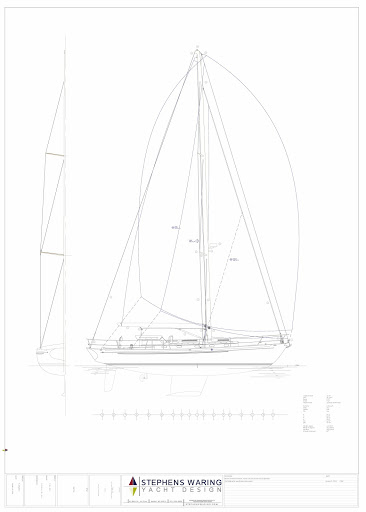 If you’re a regular reader of our newsletter, you’re familiar with our work, our yachts and our Spirit of Tradition approach to design. You’ll have noticed that several times a year, we’re able to share with you our enthusiasm as proud owners take to the seas with our latest collaborations. Yachts that combine the very latest technology and engineering with the soul and aesthetic of the classic yacht era.
If you’re a regular reader of our newsletter, you’re familiar with our work, our yachts and our Spirit of Tradition approach to design. You’ll have noticed that several times a year, we’re able to share with you our enthusiasm as proud owners take to the seas with our latest collaborations. Yachts that combine the very latest technology and engineering with the soul and aesthetic of the classic yacht era.
In August we did just that, sharing with you the launch of s/y Italmas, a collaboration with Michigan-based Van Dam Custom Boats. But Italmas was more than a Spirit of Tradition yacht and more than a combination of classic lines and contemporary materials. What made Italmas truly special was the lengths we, as designers, and Van Dam, as our collaborators, were able to go to achieve the owner’s vision.
As they say, “It always comes down to the details.” Well, the attention to detail on Italmas is second to none – so we thought we’d go one step further here, revealing to you the lengths all of us went to in crafting a truly one-of-a-kind yacht. We hope you enjoy reading about her, as much as we enjoyed designing her!
It’s about the journey, as much as the destination
One of the most interesting aspects of the Italmas development process was the remarkably collaborative experience we shared with client and builder over her long arc of conception. What transpired was a highly tailored custom design built with our friends at Van Dam Custom Boats. This project perfectly illustrates how highly evolved customized details can answer the cause to a clients’ best wishes. Her modern foil-shaped fin keel, powerful spade rudder, and a lofty rig are set as a centerpiece for her sailing platform. And, though traditional in proportion, every detailed solution employs modern thinking – how best to utilize a range of materials from solid Spruce and stainless steel to specialized carbon fiber structures to handle the most current hardware applications.
This month we thought it would be a great opportunity to walk through the thinking that went into creating a modern, high tech mast constructed of solid wood; introduce some of the decisions that were made and how we address challenges more broadly.
Italmas sports a fractional sloop rig with a sail plan designed and proportioned to carry a large main sail loaded into a roller-furling boom. This works in concert with a non-overlapping jib handled by an electric heads’l furler. Her downwind sails are simple and manageable for cruising with a furling reacher set from the masthead, as well as the option for flying the asymmetrical spinnaker. We worked with separate teams to develop the specification of sails and boom to complete this picture. Quantum Sails, of Traverse City, MI, were instructive and helpful responding to the needs of a custom project, such as this. Offshore Spars, of New Baltimore, MI, collaborated with us to marry their unique roller furling boom into a traditional looking wooden spar.
It started…with spars
Earlier on in the design process, we assumed a typical specification for carbon mast and boom spar package, for light weight and stiffness, and the smooth handling that modern fittings assure.

However, as this project evolved, our client decided the boat just wouldn’t be right without the glowing warmth, solidity and period-appropriate look of wood spars. This choice would take the Spirit of Tradition theme to an even higher level, as it became evident that our client was aiming for a cohesive, period-looking yacht that combined updated technology with the honest-to-goodness traditions seen only in vessels from the Golden Age.
Wooden spars slipped out of popularity in the mid-twentieth century. At that time, state of the art involved bronze strap tangs, secured by myriad groupings of small wood screws to spread the load over large areas of the relatively low-density wood. Goosenecks were built with heavy castings, combined with hand-operated worm-driven roller-reefing equipment and the spars were supported with swaged wire stays and clevis pins. All rather complex, elastic, and… let’s face it, rather agricultural in appearance. Our job was to to streamline this antique approach.
With the client’s desire to maintain some of the mid-century elegance, we worked hard to eliminate clutter caused by multiple layers of thin plate and small fasteners, bringing the hardware into harmony with the cleaner aesthetic and higher performance of modern stainless rod rigging. A process of combining wood, composite fiber and adhesives (as we do with many of our structural design solutions throughout the yacht) provided strength where needed while conserving overall weight. The result was a beautifully varnished wooden mast that is decorated with highly refined stainless hardware from masthead to mast step.
General construction details
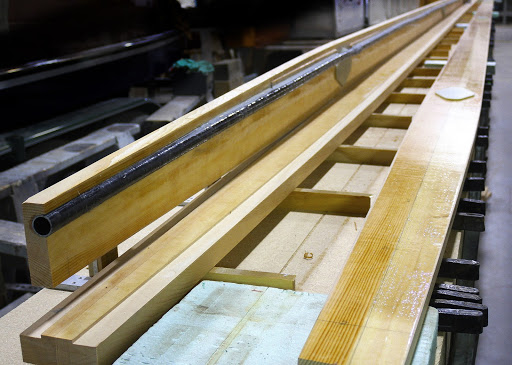
Italmas exemplifies architectural cues from the 1940’s era. During this time, it was routine for spars to be constructed of four solid planks forming a rectangular section to the mast wall structure. This is efficient for construction and, for our purposes, leaves a large hollow core running the entire tube length of the spar. Back in the day this was typically left unused. With today’s composite and aluminum spars, it’s easy to run internal halyards and wiring to navigational fixtures. Now contrast this with thicker walls of a wooden spar. Space is constrained so leading halyards through became quite a challenge as we strived to meet the brief by creating something uniquely blended between tradition and modern application.
Note the composite tube bonded into the sidewall of the spar, above: this is a chase to protect the wiring from halyards running by and to provide easy access to updating and running wire for any future rework.
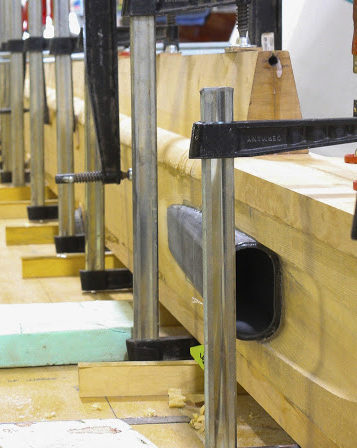
The four planks making up the walls of the spar are carefully fitted together at joints in each corner. Before assembly, we consider each function the mast must provide. All internal structural solutions are carefully designed and built at each unique location up the spar, marrying our sail plan to the details’ reality.
Note, the carbon fiber laminate structure peering out through the sidewall of the spar. This is a carefully crafted internal structure that becomes a pass-thru for both jib and spinnaker halyards. These lines are managed by Ronstan’s soft clutching system which operates much-like a Chinese finger trap for stopping the halyards in place while loaded with sails. Because of the dimensional requirements for the hardware and the need to replace wall structure back into the mast, a complex component is engineered to address the very odd geometry and literally becomes a crucial structural element.

Every decision made leads back to the original mission of keeping a cohesive look to a period design. Consider the mains’l track: it must work with a modern roller furler. It should also look simple, elegant and have some tie to the period. A trapezoidal piece bonded to the spar’s aft wall, built of solid wood, helps to disguise a geometrical challenge.
This lengthy wedge-shaped transitional piece tapers and fades into the aft wall of the mast. Located between the boom and first spreader, it provides a track for the mainsail bolt rope via the carbon tube bonded within (see picture). Finally, we designed the tapered geometry to perfectly align the movement of the mainsail through the track, down onto the boom’s furler.
Masthead is a busy place
Because multiple details converge here, the fitting must resolve several complexities in an efficient compact piece.
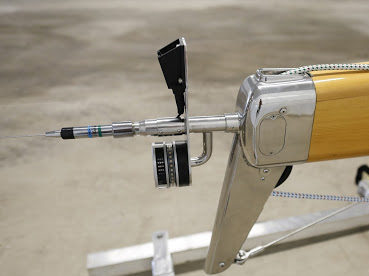
It all begins with load-management. Most important are the heavily loaded spinnaker and mainsail halyards running through, but the backstay is also terminated out on the crane extending aft over the main. The fabrication may see multiple points become loaded in various off-axis directions all at once.
The other focused challenge we have is navigational gear and electrical protection. At the top, note the vhf and combination light for running and standing at anchor. The foundation for the wind instrument wand is placed forward.
Within the fitting, the flush removable plate provides internal access to the top of the wiring conduit, as well as to the terminal (concealed within) for the heavy cable that provides lightning ground for mitigating any potential strikes that may hit the ship during her service.
The masthead is one of many fabricated pieces that exemplifies the great attention to detail taken by Van Dam’s skilled machine shop. This piece, and many others, are made from a combination of flat plate, sections from standard stainless pipe, or detailed milling of solid stainless billet. Every piece has a high degree of attention to finished plate thickness and streamlined welds with an eye towards lighter weight and beauty.
Moving down the mast – from forestay tang…
A technical drawing illustrates the strategy for creating and building a forestay tang that incorporates the jib halyard sheave. This strong point attachment must handle the loads of the forestay where it is doing much of the work for keeping this mast in place, standing straight and steady.
Note the attachment details showing a G-10 plate bonded into the mast and concealed behind the tang plate. This is both an aesthetic challenge and a necessary solution to provide local reinforcement within the mast wall where heavy bearing loads must be absorbed by the tang fitting and fasteners holding it in place.

To spreader specifics
Two of the more unique pieces of hardware concepts seen on this mast, the spreader tip and root fabrications, work deliberately to save weight and streamline the attachment of stays in a beautifully crafted piece of stainless.
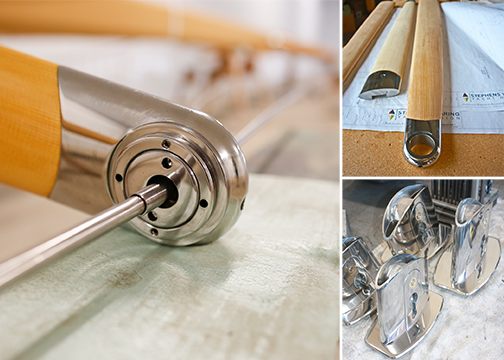
Machined from solid billets and welded together, great attention to detailed design and fabrication is on full display here. The wall thicknesses vary: around 3mm for most, thicker where specifically required. As seen in the picture, the lower spreader root fabrications, the attachment of the spreader and the upper terminal fittings of the D1 diagonal stays are streamlined into the same fitting.
Simple elliptical sections were employed when carving the lengths of solid spruce that makes up each of the 4 spreaders. This is a small refinement to the more conventional rectangular section of spreaders found in the 40’s era, yet not an entire leap to a foil shaped spreader that may be found in modern times. This lends a softer look and more enhanced shape to the hand, and gives some further efficiencies to the spreader. This shaping is carried out to the tip fitting that retains the terminal cup hardware seen installed on more typical modern composite spars.
Carved from pieces of solid billet, every effort is made to make a complex hollowed out shape within the fitting. A 3D milling operation proved both convenient and more efficient for the removal of excess material when compared to the expense, limits and challenges seen with producing solid stainless castings.
Radar reinforcements done right
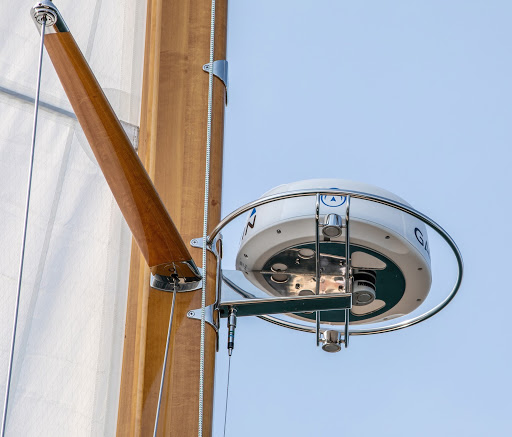
A radar fixture was not a typical piece of equipment for the 40’s era yacht. With these installations, it’s important to consider a tacking and flapping headsail making its way around the unit without causing undue damages to the sail and the rigging, and least of all, to wiping the antenna clean off the mast.
The fabrication combines the steaming light, tucked just under the radar, and is fitted with deck lighting for illuminating the working conditions on deck while sailing at night. Placing the array overhead up near the first spreader gives good sight-lines for those foggy day scans where extended ranges are needed.
From brute force clutches, to clever line constrictors
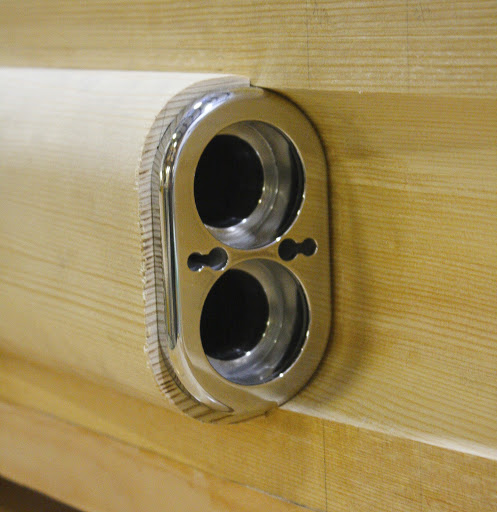
A notable feature to the spar speaks to the implementation of a line clutching system that is new(ish) to the sailing world. Ronstan recently launched their Constrictor product, a ‘textile rope clutch’ aimed at solving a common challenge onboard sailing vessels: halyard stopping.
Many clutches and jammers operate with a sort of ‘brute force’ by gripping the line with hardened metal jaws integrated into a clumsy housing bolted to the deck, a cockpit structure, or the sidewall of the mast. A lever is operated to engage the clamp, grip, or jam around the line to keep it from slipping. On the higher load halyards, such as the main halyard, it isn’t uncommon to see a doubling up of clutches to minimize the slippage while a halyard is under load.
Here, we incorporated Ronstan’s Constrictor clutches in a complex structure–a carbon foundation projecting through the spar’s sidewall. Instead of the more common ‘brute force’ approach, these constrictors rely on a friction relationship, much like a towing sock or cable grip. They’re made of helical mesh tubing woven from synthetic fiber. This configuration provides strong holding power technology, similar to that of a Chinese finger trap, only more durable.
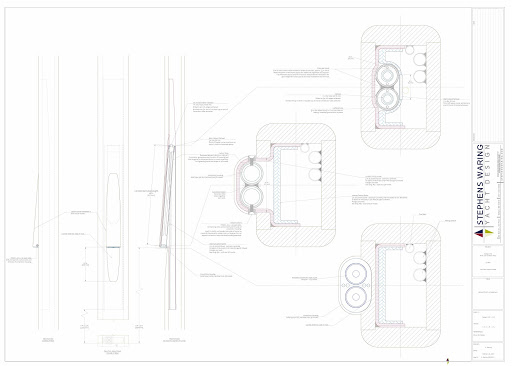
The direct relationship of a constrictor’s length with its holding capacity brings different considerations to the installation of the fixture. As indicated in the drawing, it is easy to address the loads taken by the hardware, but requires the necessary length to install the simple geometries.
Due to a lengthy projection through the sidewall of the spar, an internal composite carbon fixture is employed. This creates a tunnel through the solid wood wall that will carry the compression loads imparted by the halyards, as well as provide the necessary reinforcement that ties the mast tube together after such a structural alteration to its wall.
In these sections, note the joinery and conduit details and the carbon fiber tunnel that houses the two constrictors.
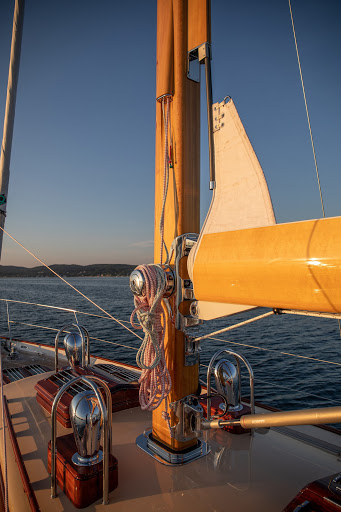
Building the gooseneck and boom
It was crucial to the success of this sail plan to provide modern tools for managing sails. For our client, that meant a roller furling jib and main were top priority. The challenge for us was how to best create a roller furling main boom without starting from scratch. When we approached Offshore Spars about this idea, their response was enthusiastic! We soon had a solid strategy for linking their efficient and sexy carbon electric roller-furling boom with this modern-traditional wooden mast.
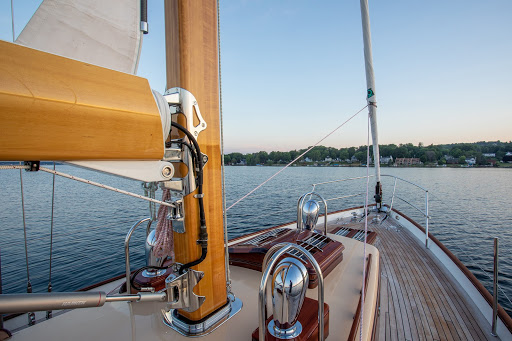
Details such as these require efforts from both architects and builders to resolve structural and construction detail, as well as sail-makers and other technicians for refinements to systems operations.
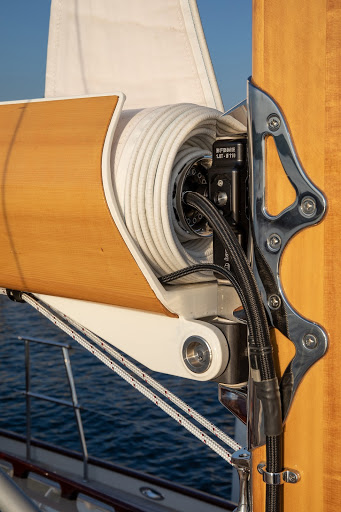
We collaborated with Offshore Spars to resolve tolerances in our fabrication designs, making sure vang and gooseneck fittings fit together well and that we had acceptable mains’l track ramp geometry – all of which were needed to provide seamless operations to our client.
Stephens Waring aims for solid performance within all of our projects. This goal aligned particularly well with the design brief for Italmas. With the help of our collaborators we were able to deliver on the challenge of a highly detailed custom yacht and keep solid performance as our north star.
After great anticipation for her success, the 43-foot sloop was launched this season. We know that her owner has been putting her through her paces all summer long, dancing his beautiful boat across Lakes Michigan and Superior. The photos of a perma-grin plastered across his face attest to his pleasure in making manifest his dream: Italmus, a high performance, one-of-a-kind classic yacht.